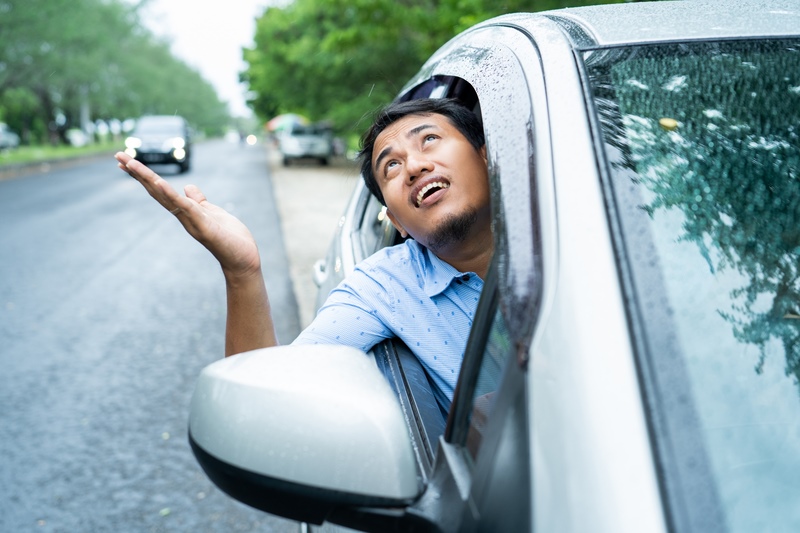Don’t be des-POND-ent.
The weather has been rather temperamental lately, hasn’t it? Just when we thought hot days are upon us, the skies have opened up to grant us heavy rain instead of April showers recently. Which has led to pockets of ponding flooding in areas around Singapore.
Driving through a flood can be extremely dangerous and can lead to serious accidents. Check the weather and news reports and always try to find an alternative route that avoids areas submerged under water. However, if you find yourself in a situation where you must drive through a flood, here are some tips and precautions to help you do so safely.

Check the water depth
You can check the depth of the water by watching other vehicles or pedestrians passing through it. Do not attempt to drive through water deeper than the bottom of your car doors. Water can seep into the engine, transmission, or other parts of your car and cause significant damage. This can be very expensive to repair. Even a small amount of water can cause your car to stall or lose traction.
Furthermore, if you cannot see obstructions like debris or tree branches in the water, they can end up damaging your vehicle or causing accidents. If you’re not sure how deep the water is, don’t risk it.

Proceed slowly and steadily
If you decide to drive through a flood, slow down and avoid sudden movements such as hard braking or turning. Keeping your speed low reduces the risk of hydroplaning. Hydroplaning occurs when your car tyres lose their grip on the road and impacts your ability to steer and brake.
Driving fast can also create a bow wave that can cause water to enter your car engine. It can also cause your car to splash water onto pedestrians and other drivers as well. Shift to a low gear to help maintain traction and control, and to prevent accidents to others on the road.
>>READ: Tips for driving safely in the rain
Avoid cruise control
It is not recommended to use cruise control when driving through a flood. Cruise control is designed to maintain a steady speed and can cause your vehicle to accelerate unexpectedly when it encounters resistance from water. This can lead you to lose control of your vehicle, particularly if the water is deep or moving swiftly.
Additionally, using cruise control may cause your engine to work harder than necessary. This can lead to overheating or damage to the engine, transmission, or other components. In a flood situation, it is important to have full control of your vehicle’s speed and acceleration, so you can adjust and respond to any unexpected obstacles or hazards.
Maintain a distance from others
Flooding makes it difficult to control your car. Coupled with reduced visibility due to the heavy rain, you may not have enough time to react if the vehicle that you are following closely suddenly stops or swerves. Vehicles may also stall or become stranded on the road. If you are following too closely, you may not have enough time to react and avoid a collision with a stalled vehicle.
Under normal conditions, one shouldn’t be tailgating in the first place. When there is heavy rain and a flood, maintaining a safe distance is essential to ensure your safety and the safety of other drivers on the road. A good rule of thumb is to keep a distance of at least three car lengths between you and the vehicle in front of you.
If you are stuck in your car …
If you are trapped in your car during a flood, it is important to stay calm and assess the situation.
Call for help on your mobile. Be sure to provide your location, the number of people in your car, and other relevant information that can help rescuers locate you quickly. Turn on your hazard lights to make your car more visible.
In most cases, it is safer to stay in the car than to try to wade or swim through the flood. If the water is shallow and not moving too fast, you may be able to safely exit the car and seek higher ground. However, if the water is deep, moving quickly or fast rising around you, stay in the car. Your vehicle could be swept away by strong currents. It is safer to stay inside until the water subsides or help arrives.

What you should do after driving through a flood
If you have made it safely through a flooded area, gently apply your brakes several times to dry them out. Then stop at a safe area, switch off your engine, and inspect your car for any damage, including dents, scratches, or water damage.
If you had driven through a deep flood, there is a possibility that water had seeped into your car engine or electrical systems. Check for any warning lights, strange noises, or difficulty in steering and braking. If possible, dry your vehicle as soon as possible to prevent rust and mould growth.
Even if your vehicle appears to be functioning correctly, it is crucial to have it inspected by a professional mechanic. They will be able to assess if there was any underlying damage. Water damage can cause long-term problems that may not be apparent immediately.
Remember, if the road is flooded, the most important thing you should do is to prioritise your safety and the safety of others on the road. Driving through a flood is risky, and it’s always best to avoid it if possible.




















